I will review one of the most popular air purifiers of the last few years: the Blue Pure 211+ from Blueair.
Since we started housefresh.com, we have tested and reviewed a few Blueair air purifiers.
Looking at Google Trends to gauge popularity, we can see that the 211+ first arrived in 2016 and reached its peak popularity in 2021 – too late for a review?
I don’t think so…
Although Blueair has now replaced the 211+ with the new Blue Pure Max 211i, many people are still looking to buy a 211+ as it’s still widely available, and many others own a 211+ and are wondering if it’s time to upgrade it, so this review is for them.
As always, we bought the Blue Pure 211+ with our own money. I paid £110 for our 211+ in early 2022, but you can find the 211+ on Amazon today for $319.99 — or you can get the latest Pure Max 211i in the U.S. for $349.99.
In this review, I will compare the Blue Pure 211+ to the more than 100 air purifiers we have tested at HouseFresh, based on our first-hand data on air cleaning performance, sound generation, energy efficiency, real-life user experience and long-term running costs. If you want to know more about how we test our air purifiers, please read this article or watch this video.
The lowdown on the Blue Pure 211+

“When I first tested the Blue Pure 211+ in 2022, I was blown away by its performance as it was a fairly cheap device yet could clean air very effectively.
As our new data shows, even when running at speed 2, the 211+ has an estimated CADR of around 230 cfm, and at speed 1 you will get the same performance as the Levoit Core 300 running at top speed (140 cfm).
So why do Blueair air purifiers never make it on my list of the best air purifiers?
Well, the Blueair Blue Pure range uses an ionizer process to help clean the air, which you will find in devices from Coway, Winix and Alen.
However, and unlike Coway, Winix and Alen, with the Blueair 211+ the user has no way of switching off this function. “
Looking for the quick-fire facts? Here are my main pros and cons of the Blueair Blue Pure 211+.
What we really like
What we think could be better
| HouseFresh rating: | ★★★★☆ |
| Time to clean our 728 cubic feet test room (with the device running at top speed): | 20 minutes |
| Air purifier technology: | HEPASilent™ Technology and Activated Charcoal Filter + Ionizer technology |
| Recommended room size (4.8 air changes per hour): | 540 sq. ft. |
| Clean air delivery rate (CADR): | Dust: 350 CFM Smoke: 350 CFM Pollen: 350 CFM |
| Dimensions (in inches / in cm): | 20H x 13W x 13D inches (51H x 33W x 33D cm) |
| Weight (in pounds / in kg): | 12.98 lbs (5.89 kg) |
| Filter life: | 6 – 8 months |
| Noise level in decibels (measured from 3 ft. away with a sound level meter): | Speed 1: 37.2 dB Speed 2: 45.8 dB Speed 3: 55.7 dB |
| Electricity consumption in watts (recorded with an electricity usage monitor): | Standby mode: 0.1 watts Speed 1: 16.9 watts Speed 2: 40.5 watts Speed 3: 54.5 watts |
| Estimated running cost (electricity consumption + official filter replacement): | $197.27 per year |
| Cost per CADR cfm (based on dust CFM as reported by AHAM): | $0.71 |
| Manufacturer’s warranty: | 1 year |
| Country of manufacture: | Designed and engineered in Sweden, assembled in China |
Blueair’s signature Scandi design with one-button operation
A bulkier Blueair device with a removable pre-filter fabric you can replace and customize, similar to other models in their range.
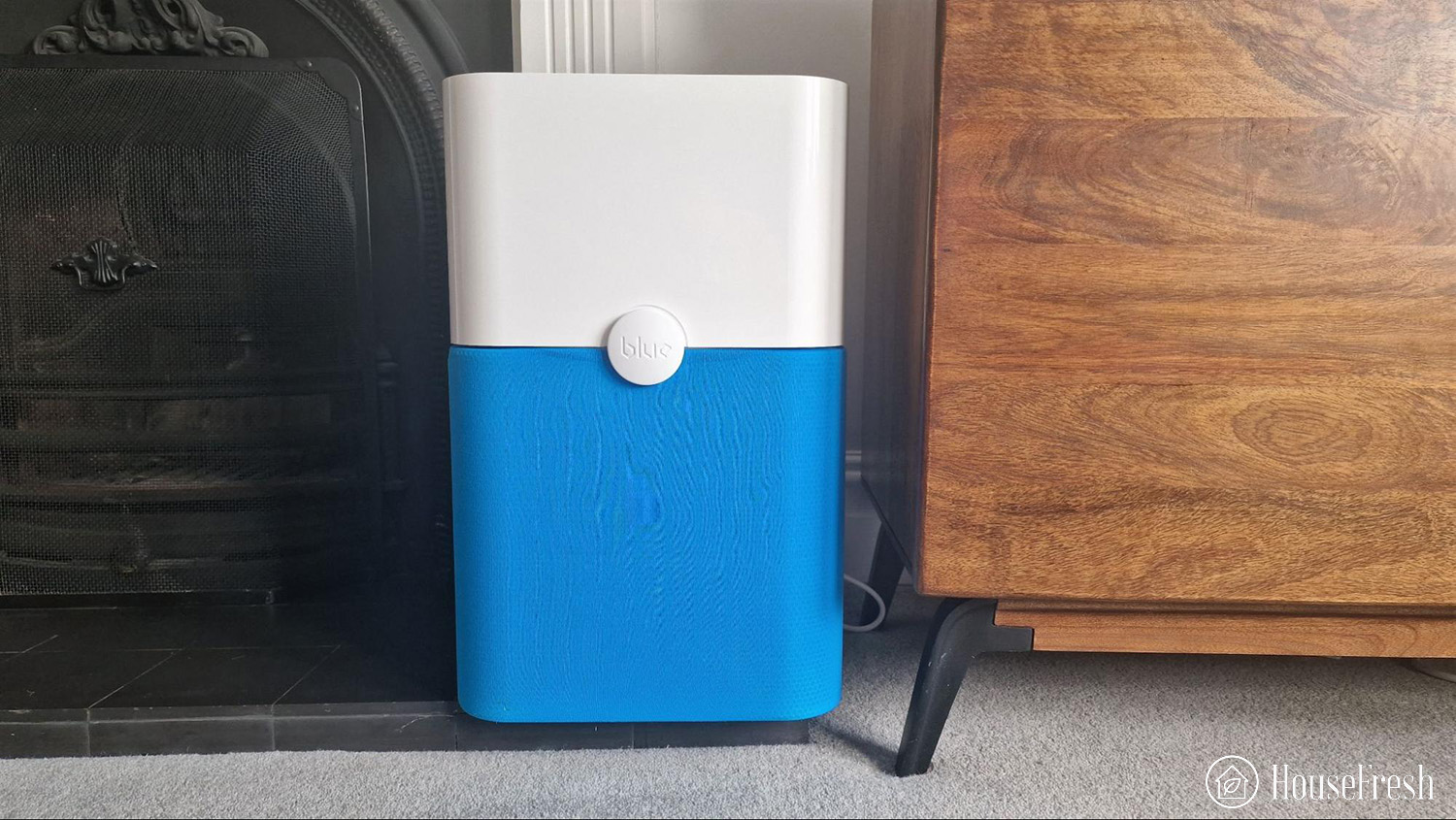
Before jumping into the performance data, let’s look at the design of the 211+.
Blueair’s Blue Pure range has a distinctive aesthetic. The fan sits at the top of the device and the filter is tucked in underneath, covered by a colorful pre-filter fabric.
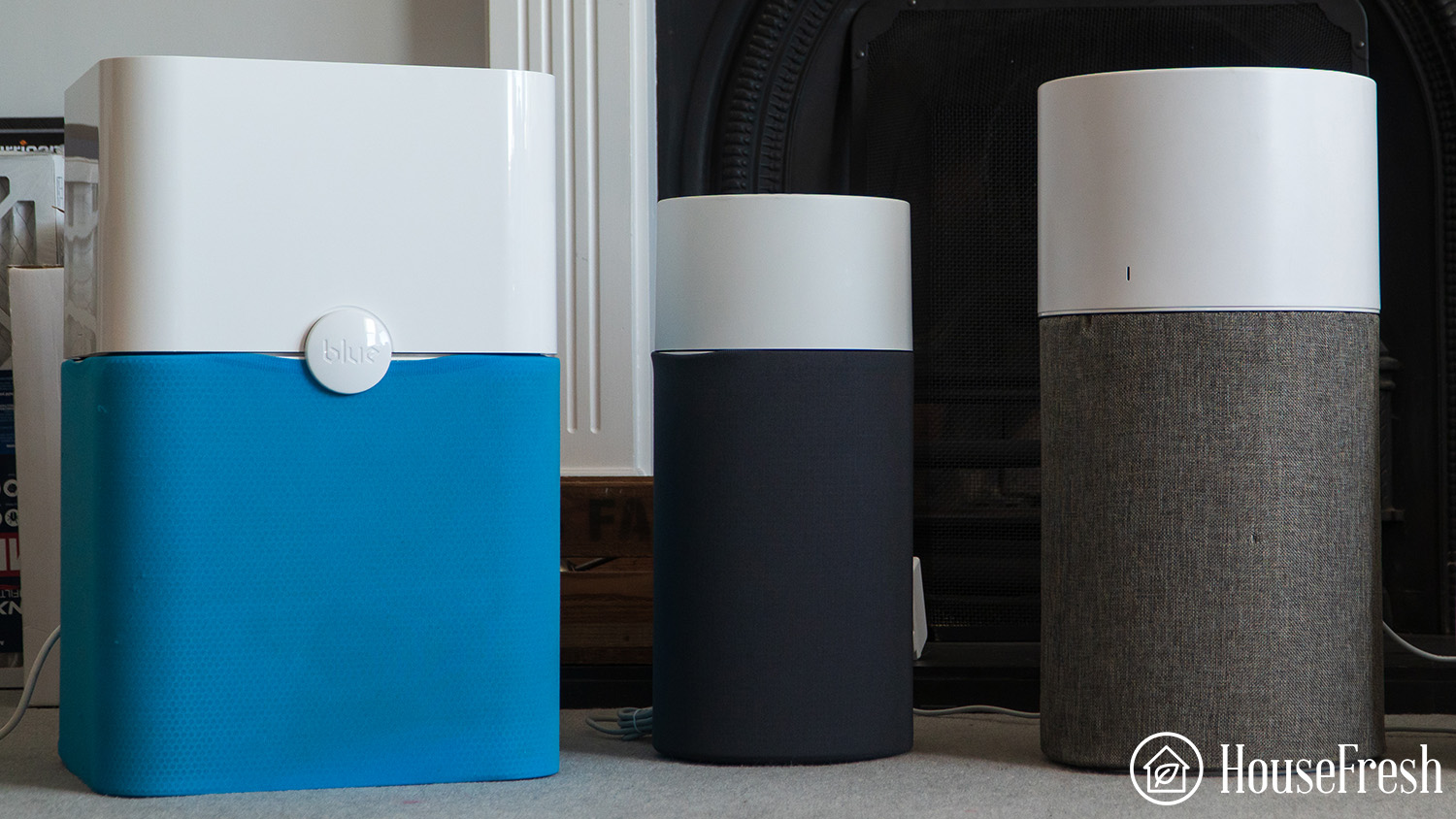
The 211+ is the largest unit in the Blue Pure range, and it takes up much space.
It takes up as much floor space as the Levoit Core 600S but it doesn’t come with any handles, so you need to carry it around in your arms to move it.
It is much bulkier than the AirFanta 3Pro, which has a higher CADR (430) and costs half the price.

The filter sits underneath the top half of the 211+ and is covered by a fabric pre-filter that comes in 5 color options to match your decor.
The controls for the Blue Pure 211+ couldn’t be simpler. There is one large circle button at the front that you can tap to move across three fan speeds and the on/off switch.
This makes the 211+ super easy to use right out of the box, but you don’t get any extra features like child lock, timers, disabling the ionizer, or any of the other buttons we see on other air purifiers as standard. As an older model, it also doesn’t have any app support.
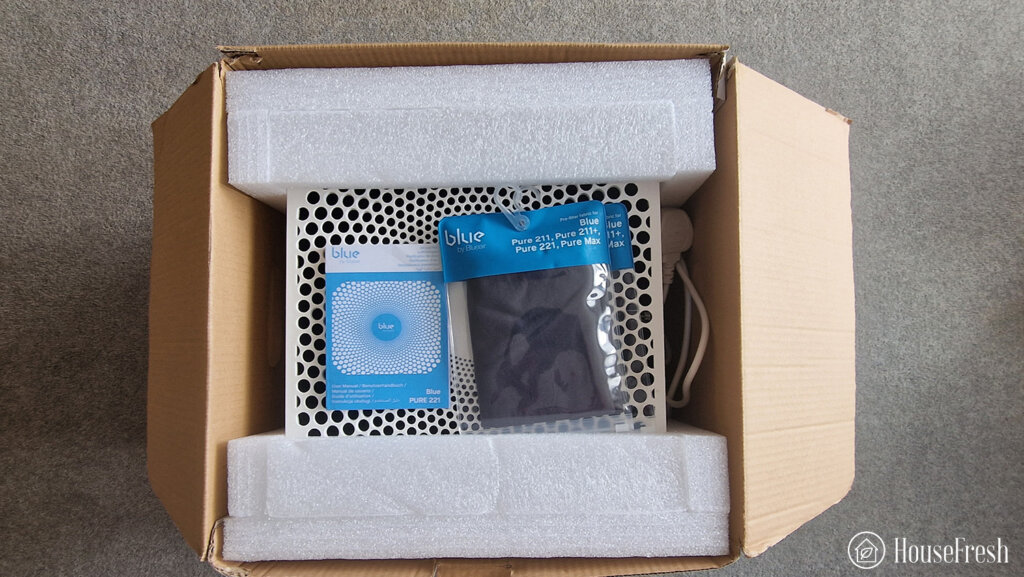
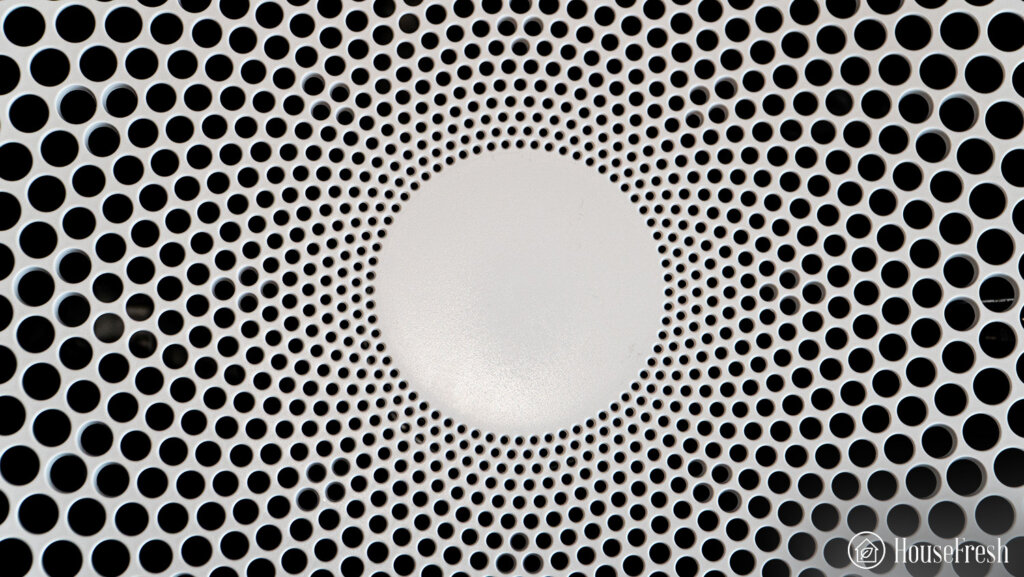
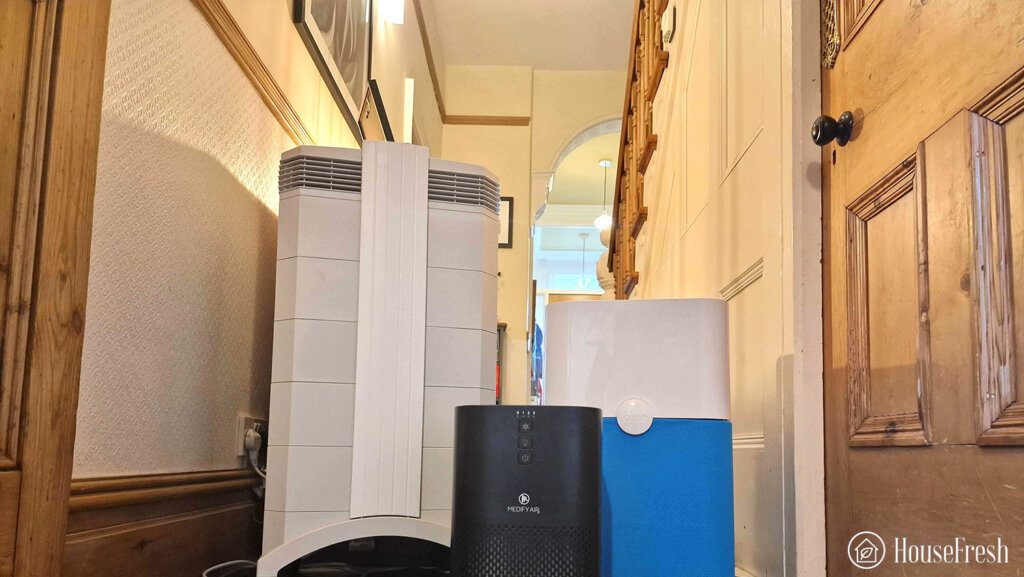
One annoying aspect of the 211+’s design is that when you pick it up to move it, the bottom half may or may not detach from the fan and fall to the ground. This doesn’t happen every time but it definitely has gotten worse over the years for my device, after each time I replace the filter.
Which brings me to the filter.
If, like me, you simply can’t live without smart mod-cons, it’s worth checking the 211+ Auto or 211i Max.
A particle filter with a layer of carbon that is supercharged with bipolar ionization
The 211+ uses Blueair’s trademarked HEPASilent filters to remove microscopic particles without noise.

The filter in the 211+ consists of four layers of filtration:
First, you get the pre-filter which is made out of fabric and comes in different colors.
As with any pre-filter, you will need to keep it clean by vacuuming it regularly. Blueair has made it easy to remove it for cases when it needs a deeper clean, so you can wash it in a washing machine using cold water.
Then, you get an ultra-thin polypropylene filter, which is the main particle filter.
As shown by the new generation of PC fan kits that use MERV 13 filters, lower-grade particle filters are not a bad thing for air purifiers, as air will pass multiple times through the filters and the higher airflow helps to improve the speed of cleaning.

Going deeper, you get a carbon filter for odors and gases.
Unfortunately, this is just a layer of carbon-impregnated fabric, so it will be less effective for VOCs and bad odors compared to the pelleted activated carbon we see in other models of air purifiers.
Looking for more protection from VOCs? Supercharge the carbon quantity in your filter by upgrading to the SmokeBlock filter.
Lastly, you get Blueair’s trademarked HEPASilent technology.
According to Blueair, its HEPASilent technology “electrically charges particles that are drawn into the device, causing them to adhere to the particle filter, where viruses and bacteria are inactivated.” The marketing materials also state that “HEPASilent filtration can deliver up to 45% more clean air faster than HEPA H13.”
What Blueair is describing sounds a lot like ionization.
Air ionizers emit electrostatic discharges into the air that alter the particles’ structure, making them heavier and forcing them to drop onto surfaces or within the device itself so they can be cleaned.
However, Blueair’s marketing materials do not mention ionization. Instead, they mention “electrostatic filtration.”
This makes sense as ionizers don’t have a great reputation because they can produce potentially dangerous by-products, including ozone, aldehydes, and fine particles, which can negatively affect the health of those with respiratory conditions.
It is worth mentioning here that Blueair air purifiers sold in the U.S. are CARB-certified, which means that their ozone emissions have been tested and proven not to surpass 50 parts per billion (ppb). They are also certified by Intertek as ozone-free…
After digging deep into their website, I found a page where they clearly explain the difference between ionizers and HEPASilent technology:
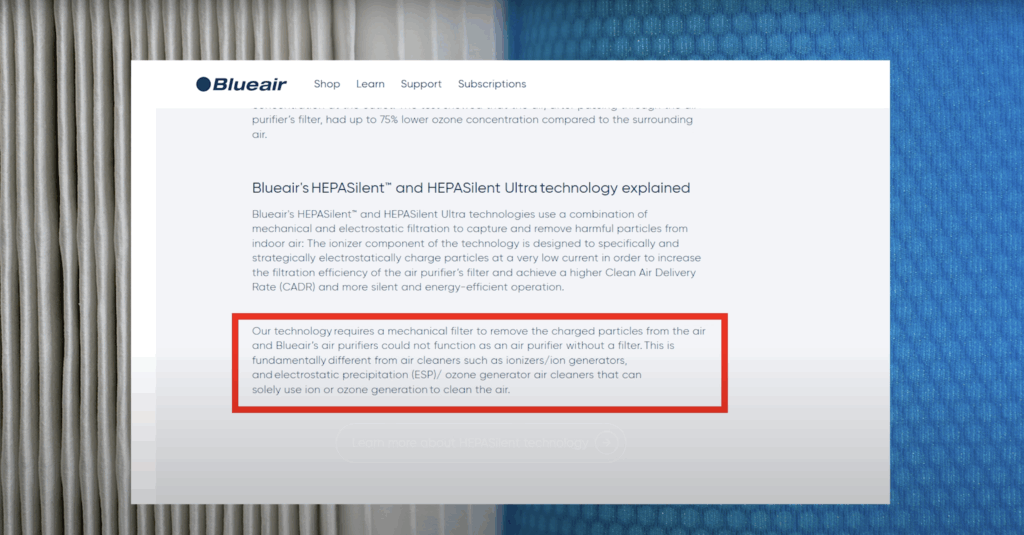
Blueair states that HEPASilent technology can’t be associated with ionizers because their devices combine electrostatic filtration with mechanical filtration.
It’s important to note that the ionizer feature cannot be turned off on this device. Many people wrongly assume it will generate ozone, but a third-party lab test by Intertek provides a certificate for zero ozone (≤ 0.005 ppm).
In terms of the filter itself, it is straightforward to install; simply twist the body of the purifier and slot it inside with the carbon filter facing upwards. Here’s a video on how to do it.
As with all new filters, remember to remove the filters from the plastic wrapper before turning on the air purifier.
The Blue Pure 211+ cleared our test room in 20 minutes
This is faster than some of our most recommended air purifiers, such as the Levoit Vital 200S and the Winix 5500-2.

We first tested the Blueair 211+ back in 2022 using our PurpleAir Indoor sensor, so before I started working on this video review, I re-tested the 211+ using our new PurpleAir Zen sensor:
According to our Zen sensor, the 211+ needed 20 minutes to achieve PM1 zero in our 728 cubic ft. test room:
We can compare this to other similarly-priced devices running at their top speed:
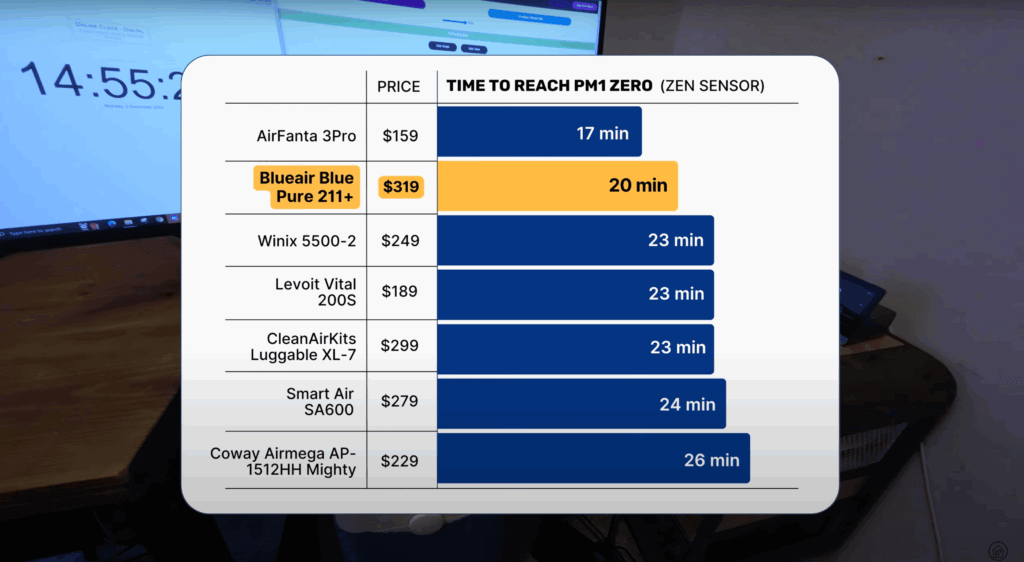
Considering this air purifier was released in 2016, the results at top speed are impressive.
As I mentioned above, the Blueair Blue Pure 211+ comes with electrostatic filtration through their HEPASilent technology but (unlike manufacturers such as Winix, Alen and Coway) Blueair doesn’t allow you to turn off the HEPASilent in the 211+.
Smart Air has long stated that “adding an ionizer is an extremely cheap way for an air purifier company to increase its purifier’s CADR,” so I was intrigued to see how much of an effect Blueair’s HEPASilent has on the 211+’s performance.
After much deliberation, I made the drastic decision to remove the ionizer:

With HEPASilent enabled, the Blue Pure 211+ completed our air cleaning test in 20 minutes. Without HEPASilent, the same test took a whooping 38 minutes.
Before running the test, I assumed that HEPASilent would boost air cleaning performance a little, helping the 211+ complete our particle removal test just a few minutes faster than without HEPASilent as this is what we usually see with other air purifiers when we disable their ionizers.
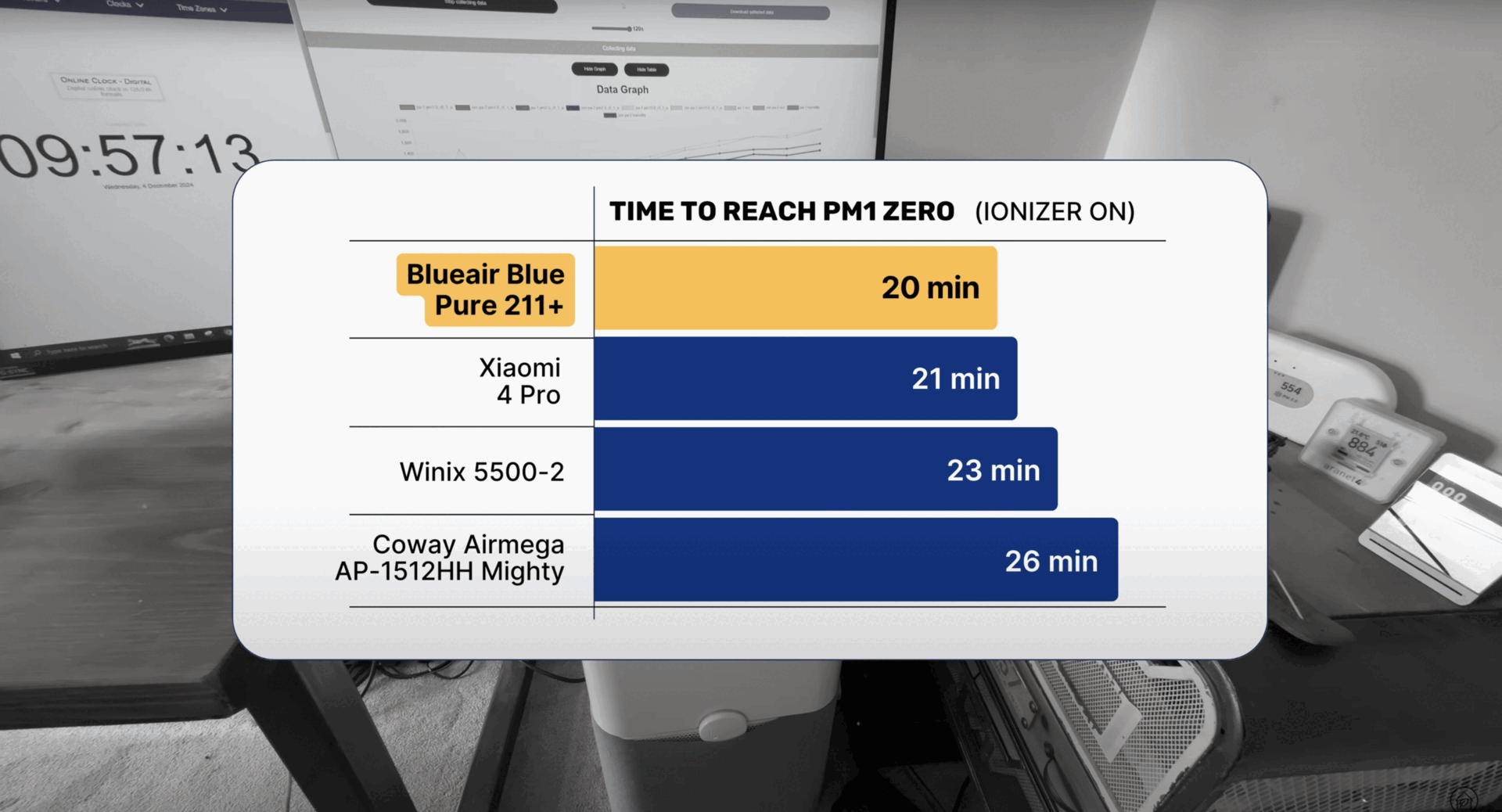
However, as the table above shows, removing the ionizer in the 211+ had a much bigger impact on air cleaning performance compared to other air purifiers.
In fact, our test shows that removing the ionizer in this Blueair device led to a 62% drop in performance.
So if you were considering removing the ionizer inside your Blue Pure 211+, keep in mind that you will significantly reduce its air cleaning performance.
I believe this explains why Blueair doesn’t include an option to disable HEPASilent in the same way other manufacturers do.
Incredibly quiet considering its size
In our testing, the sound levels of the 211+ ranged from 37.2 dBA to 55.7 dBA
If an air purifier is too loud, you will find yourself turning it off eventually.
That is why we always measure how much sound they generate from 3 ft. away.
These are the results for the 211+:
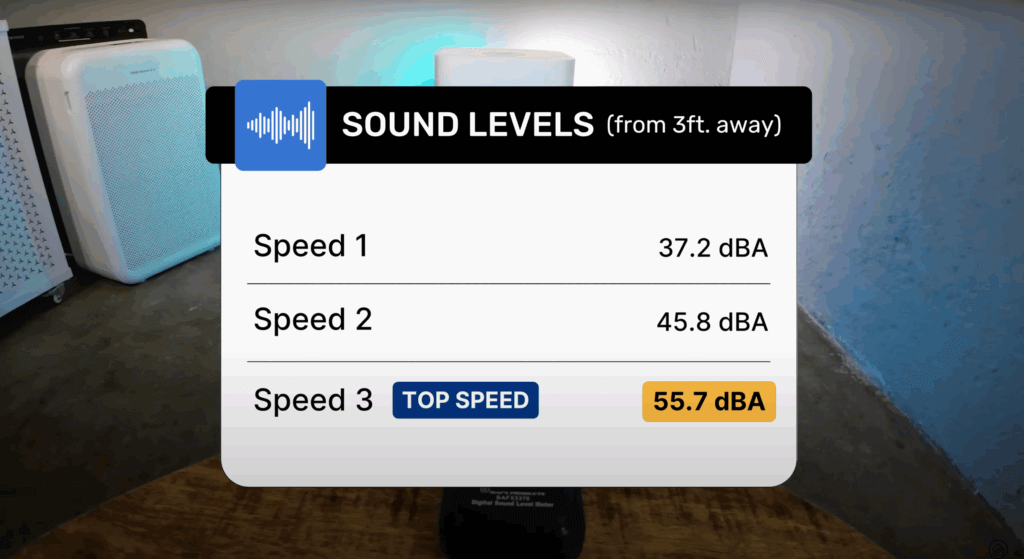
Be aware our background noise is 35 dBA, so the 211+ running at speed 1 is likely to generate less sound if you could measure it in a silent room.
But feel free to have a listen for yourself:
As these figures won’t tell you much in isolation, I made a comparison with other devices that have similar performance:

The 211+ is quieter than most when compared to other similarly powered HEPA retail devices. However, it is out-matched when we compare it to PC fan-powered devices like the Luggable XL-7 from CleanAirKits.
One of the benefits of a high-CADR air purifier is that you can use it on a lower fan speed and still achieve a good level of air cleaning performance.
So we retested the particle removal performance of the 211+ when running at its lowest fan speeds.
Running at speed 2 it generates 45.8 dBA, which is just above the 45 dBA limit that CleanAirStars recommends for noisy classrooms or offices. it managed to reach PM1 zero in 28 minute
When running at speed 1, it generates 37.2 dBA, which is below the 40 dBA recommended for quiet classrooms and offices. At speed 1, the 211+ reached PM1 zero in 45 minutes.
We can compare these results with other air purifiers running at sub-45dBA:
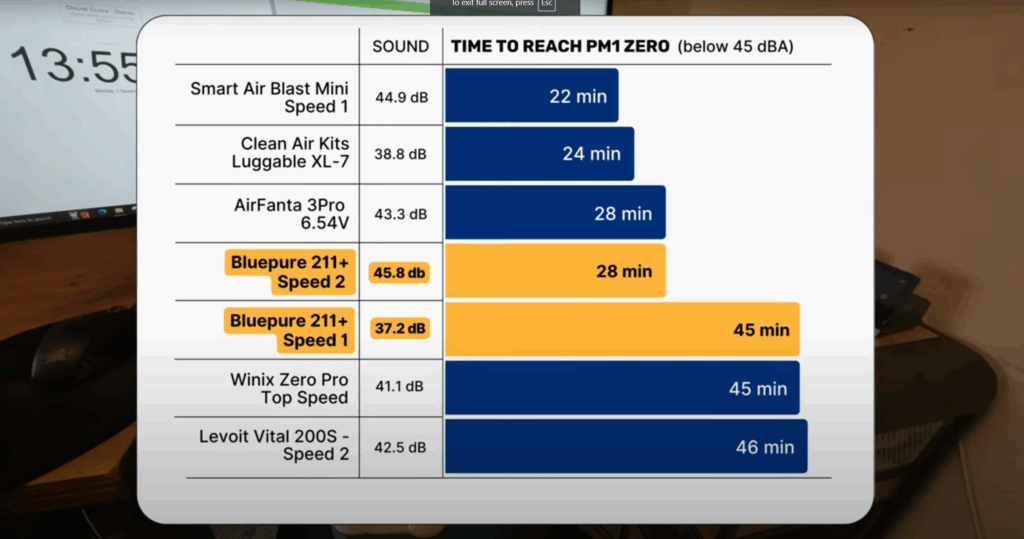
Running at lower fan speeds, the Blue Pure 211+ performs well when benchmarked against other similarly powered devices we have tested at low speeds. This is likely to be thanks to its HEPASilent technology.
However, concerning performance at low sound levels, the 211+ is still no match to PC fan-powered air purifiers like the AirFanta 3Pro or the CleanAirKits Luggable XL-7.
Let’s look at how much the 211+ will cost you in the long term, starting with your energy bill.
The cost to run a Blueair Blue Pure 211+: $197.27 per year
1. Electricity costs = $57.29 per year
As always, we used our energy meter to record the 211+’s energy use when running at each fan speed and also while on standby.
I also measured how much power was used once I removed the ionizer.

If you had to leave your Blueair 211+ running 24/7, it would cost $57.29 per year in energy costs.
With this calculation in mind, we can compare the annual energy costs you can expect from the Blueair 211+ to other devices we have tested:
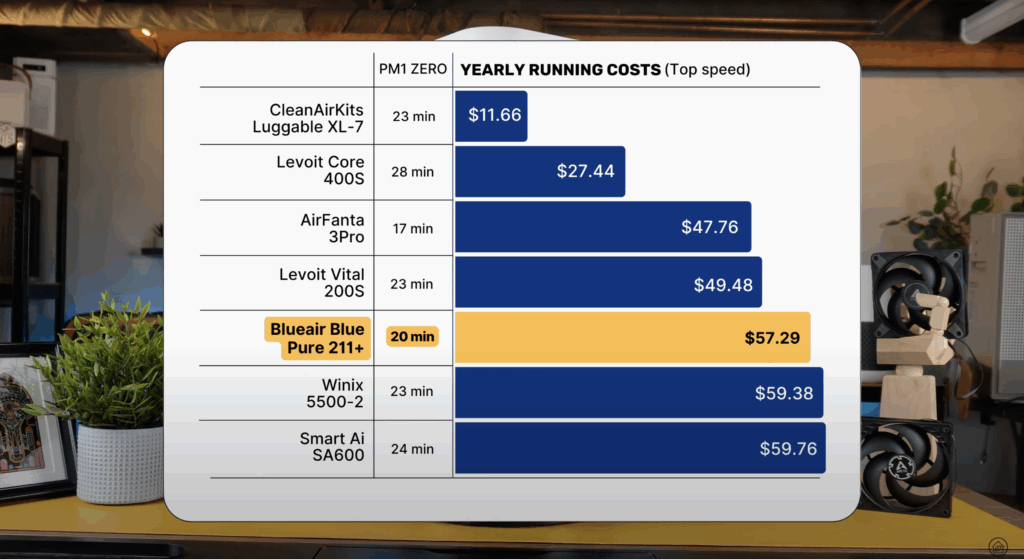
Energy usage compared to performance is very fair with the Blue Pure 211+, which must be due to the combination of a lower-grade particle filter and electrostatic filtration.
2. Filter costs = $139.98 per year
It’s not just energy costs that add to the running cost of an air purifier and you will also need to replace the filters eventually.
Blueair says you need to replace the filters for the Blue Pure 211+ every 6 months. The recommended OEM filters cost $69.99 for the standard filters, but they do offer options with extras that go up to $89.99.
This means the total filter costs for one year for the Blue Pure 211+ is $139.98; We can combine that with energy costs and compare with other similar performing air purifiers:
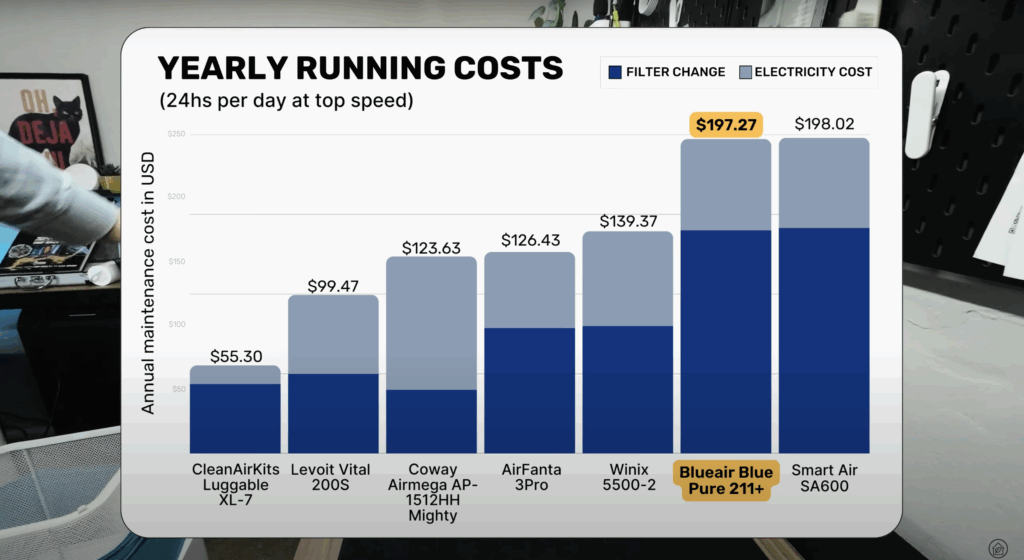
The Blue Pure 211+ is this group’s second most expensive air purifier, costing over three times more than the Luggable XL-7 and nearly twice as much as the Vital 200S.
This is likely due to the lower filter life, as the filter needs replacing every 6 months, compared to 12 months for the Levoit Vital 200S.
Bottom line: Is the Blueair Blue Pure 211+ worth it?
Its combination of a lower-grade filter and ionization function provides good air cleaning power at lower fan speeds.

When I first reviewed the Blue Pure 211+ in 2022, I was blown away by its performance because it was a relatively cheap air purifier, yet it could effectively clean the air.
As our new data shows, even when running at speed 2, the 211+ has an estimated CADR of around 230 cfm, and at speed 1 you will get the same performance as the Levoit Core 300 running at top speed (140 cfm).
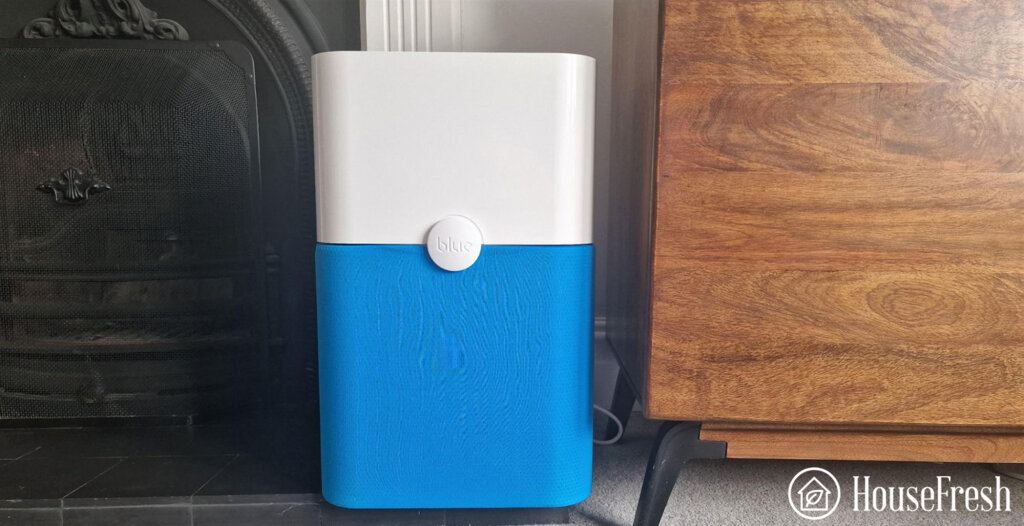
So why did Blueair air purifiers never make it to my list of the best air purifiers?
Well, the Blueair Blue Pure range uses an ionizer process to help clean the air, which is also found in devices from Coway, Winix and Alen.
However and unlike Coway, Winix and Alen, with the Blueair 211+, the user has no way of switching off this function.
To be clear, I don’t believe that the Blue Pure 211+ creates large amounts of ozone. I was unable to detect any with my ozone detector after leaving it running and it also has a certificate from Intertek to state it creates less than 0.005pm of ozone.
If you do have one, the performance is good as long as you have no issue with the ionizer, and know it can be very effective even when running on lower quiet fan speeds.
SOURCES
We calculated yearly costs associated with running the Blueair Blue Pure 211+ 24 hours a day, 365 days per year, utilizing the Appliance Energy Calculator developed by the U.S. Department of Energy as of March 2025.


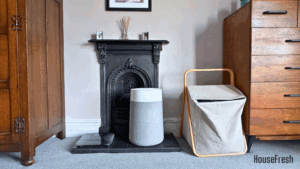
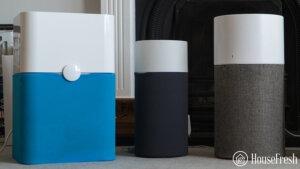


Need Advice? Ask the Community